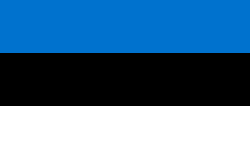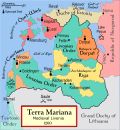Estonia
Estonia /isˈtoʊniə/ (![]() listen) (Estonian: [Eesti] Error: {{Lang}}: text has italic markup (help)), officially the Republic of Estonia (Estonian: [Eesti Vabariik] Error: {{Lang}}: text has italic markup (help)) is a small country in the Baltic states of Northern Europe. The capital city is Tallinn. Estonia has borders with Sweden, Finland, Russia and Latvia. Its population is 1,332,893.[10]
listen) (Estonian: [Eesti] Error: {{Lang}}: text has italic markup (help)), officially the Republic of Estonia (Estonian: [Eesti Vabariik] Error: {{Lang}}: text has italic markup (help)) is a small country in the Baltic states of Northern Europe. The capital city is Tallinn. Estonia has borders with Sweden, Finland, Russia and Latvia. Its population is 1,332,893.[10]
Republic of Estonia Eesti Vabariik (Estonian) | |
|---|---|
| Anthem: | |
![Location of Estonia (dark green) – on the European continent (green & grey) – in the European Union (green) — [Legend]](https://upload.wikimedia.org/wikipedia/commons/thumb/a/a2/EU-Estonia.svg/500px-EU-Estonia.svg.png) Location of Estonia (dark green) – on the European continent (green & grey) | |
| Capital and largest city | Tallinna 59°25′N 24°45′E / 59.417°N 24.750°E |
| Estonian | |
| |
| Ethnic groups (2019[1]) |
|
| Demonym(s) | Estonian |
| Government | Unitary parliamentary republic |
| Alar Karis | |
| Kristen Michal | |
| Legislature | Riigikogu |
| Independence | |
| 12 April 1917 | |
| 24 February 1918 | |
| 2 February 1920 | |
| 1940–1991 | |
| 20 August 1991 | |
• Joined the European Union | 1 May 2004 |
| Area | |
• Total | 45,227[2] km2 (17,462 sq mi) (129thd) |
• Water (%) | 4.45% |
| Population | |
• 2020 estimate | |
• 2011 census | 1,294,455[4] |
• Density | 28/km2 (72.5/sq mi) (149th) |
| GDP (PPP) | 2020 estimate |
• Total | $49.644 billion[5] |
• Per capita | $37,605[5] (43rd) |
| GDP (nominal) | 2020 estimate |
• Total | $32.742 billion[5] |
• Per capita | $24,802[5] (35th) |
| Gini (2018) | ▼ 30.6[6] medium |
| HDI (2018) | very high · 30th |
| Currency | Euro (€) (EUR) |
| Time zone | UTC+2 (EET) |
• Summer (DST) | UTC+3 (EEST) |
| Driving side | right |
| Calling code | +372 |
| ISO 3166 code | EE |
| Internet TLD | .eee |
| |
The territory includes the mainland and 2,222 islands in the Baltic Sea.[11]
History
People have lived in Estonia since at least 9,000 BC. The oldest known settlement in Estonia is the Pulli settlement, which was on the banks of the Pärnu River.
Estonia became independent from Russia in 1920 after a brief War of Independence at the end of World War I (1914-1918). During World War II (1939–1945), Estonia was occupied by the Soviet Union and Germany. It then became the Estonian Soviet Socialist Republic and lost its independence.
Estonia had its independence restored in 1991.[12] It became a member of the North Atlantic Treaty Organization (NATO) on 29 March 2004. It joined the European Union on 1 May 2004.
Politics
In January 2021, Estonia became the only country in the world led by women by having a female president (Kersti Kaljulaid) and female prime minister (Kaja Kallas).[13] A few months later, Alar Karis replaced Kaljulaid as president and in 2024 Kristen Michal replaced Kallas as Prime minister.
The foreign intelligence service warned in 2024 that Russia intended to double the number of its troops stationed along its border. Estonia plans to spend more than 3% of GDP on defence.[14]
Geography
Estonia is bordered to the north by the Gulf of Finland with Finland on the other side, to the west by the Baltic Sea with Sweden on the other side, to the south by Latvia (343 km), and to the east by Lake Peipus and Russia (338.6 km).[15]
Average elevation reaches only 50 metres (164 ft). The country's highest point is the Suur Munamägi in the southeast at 318 metres (1,043 ft).
Estonia has many forests, almost 50% of the land is covered with forests.[16] The most common tree species are pine, spruce and birch.[17] Estonia has over 1,400 lakes and over 2,000 islands. The longest rivers are Võhandu (162 km or 101 mi), Pärnu (144 km or 89 mi), and Põltsamaa (135 km or 84 mi).
Biodiversity
Mammals in Estonia include the grey wolf, lynx, brown bear, red fox, badger, wild boar, moose, red deer, roe deer, beaver, otter, grey seal, and ringed seal. The critically endangered European mink has been successfully reintroduced to the island of Hiiumaa. The rare Siberian flying squirrel is present in east Estonia.[18][19]
Over 300 bird species have been found in Estonia. These include the white-tailed eagle, lesser spotted eagle, golden eagle, western capercaillie, black and white stork, many species of owls, waders, geese and many others.[20] The Barn swallow is the national bird of Estonia.[21]
Protected areas cover 18% of Estonian land and 26% of its sea territory. There are 5 national parks, 159 nature reserves, and many other protection areas.[22]
Government
The Riigikogu is the name of the parliament in Estonia.
Administrative regions
Since administrative reform in 2017, there are in total 79 local governments. This includes 15 towns and 64 rural municipalities. All municipalities have equal legal status and form part of a county, which is a state administrative unit.[23]
The counties are:
Culture
According to speedtest.net, Estonia has one of the fastest Internet download speeds in the world with an average download speed of 27.12 Mbit/s.[24]
Estonia won the Eurovision Song Contest in 2001 with the song "Everybody" performed by Tanel Padar and Dave Benton. In 2002, Estonia hosted the event.
The Estonian National Day is the Independence Day celebrated on 24 February. This is the day the Estonian Declaration of Independence was issued. As of 2013[update], there are 12 public holidays and 12 national holidays celebrated each year.
In June 2023, the Estonian government passed a bill legalising same-sex marriage and same-sex adoption in Estonia.[25] The bill went into effect on 1 January 2024, making Estonia the first Baltic state and country formerly occupied by the Soviet Union to legalise same-sex marriage and adoption.[26][27]
International rankings
The following are links to international rankings of Estonia.
| Index | Rank | Countries reviewed |
|---|---|---|
| Freedom House Internet Freedom 2016 | 1 | 65 |
| International Tax Competitiveness Index 2023[28] | 1 | 38 |
| Environmental Performance Index 2016 | 8 | 180 |
| Index of Economic Freedom 2017 | 6 | 180 |
| Reporters Without Borders Press Freedom Index 2011–2012 | 11 | 187 |
| State of World Liberty Index 2006 | 1 | 159 |
| Human Development Index 2019[29] | 30 | 189 |
| Corruption Perceptions Index 2016 | 22 | 176 |
| TRACE Matrix business bribery risk 2016[30] | 3 | 199 |
| Networked Readiness Index 2014 | 21 | 133 |
| Ease of Doing Business Index 2017 | 12 | 190 |
| State of The World's Children's Index 2012[31] | 10 | 165 |
| State of The World's Women's Index 2012 | 18 | 165 |
| World Freedom Index 2014[32] | 8 | 165 |
| Legatum Prosperity Index 2019 | 21 | 149 |
Estonia Media
Kaali crater in Saaremaa was created by a meteorite c. 1530–1450 BC, during the Nordic Bronze Age, in one of few impact events ever to occur in a populated area. The site was later a pagan shrine and source of meteoric iron.
Ruins of the gates to Varbola stronghold, the largest fortress of pre-Christian Estonia
Estonia and Livonia after the 12th/13th century Northern crusades
Academia Gustaviana, now University of Tartu was founded in 1632 by King Gustavus Adolphus
The Kadriorg Palace in Tallinn was built in 1718–1725 during the reign of Tsar Peter I (Emperor Peter the Great of Russia).
Friedrich Reinhold Kreutzwald (1803–1882), author of the Estonian national epic Kalevipoeg (by Johann Köler, 1864)
Related pages
References
- ↑ "Rahvaarv rahvuse järgi, 1. jaanuar, aasta". stat.ee. Archived from the original on 2020-04-20. Retrieved 2020-04-19.
- ↑ "Minifacts About Estonia 2017". Archived from the original on 3 November 2018. Retrieved 19 July 2017.
- ↑ "Population at beginning of year". Statistics Estonia. 2020. Archived from the original on 2018-12-19. Retrieved 2020-04-19.
- ↑ "Phc 2011 results". Statistics Estonia. 2011. Archived from the original on 10 October 2016. Retrieved 26 January 2016.
- ↑ 5.0 5.1 5.2 5.3 "Estonia". International Monetary Fund. 2019.
- ↑ "Gini coefficient of equivalised disposable income". EU-SILC survey. Eurostat. Retrieved 10 September 2019.
- ↑ "2015 Human Development Report" (PDF). United Nations Development Programme. 2015. Retrieved 14 December 2015.
- ↑ Constitution of the Republic of Estonia Archived 2016-10-19 at the Wayback Machine, 6th article
- ↑ Võrokesed ees, setod järel. postimees.ee (13 July 2012).
- ↑ "World Bank, World Development Indicators - Google Public Data Explorer". www.google.com.
- ↑ Matthew Holehouse Estonia discovers it's actually larger after finding 800 new islands The Telegraph, 28 August 2015
- ↑ "The August coup and Estonian independence (1991)". Estonica.org. Archived from the original on 2021-02-25. Retrieved 2019-06-26.
- ↑ Hankewitz, Sten (26 January 2021). "Estonia becomes the only country in the world led by women". Estonian World. Retrieved 26 January 2021.
- ↑ "Russia to double military presence along Nato border, Estonia warns". www.ft.com. Retrieved 2024-02-13.
- ↑ "Estonian Republic". Archived from the original on 21 July 2011. Retrieved 21 July 2011.
{{cite web}}: CS1 maint: unfit URL (link). Official website of the Republic of Estonia (in Estonian) - ↑ Facts Archived 2 February 2017 at the Wayback Machine Estonian Timber
- ↑ "European Commission – PRESS RELEASES – Press release – Land Use/Cover Area frame Survey 2012 Buildings, roads and other artificial areas cover 5% of the EU ...and forests 40%". Retrieved 27 March 2015.
- ↑ Taylor, Neil (2014). Estonia. Bradt Travel Guides. pp. 6–7. ISBN 978-1-84162-487-7.
- ↑ Taylor, Neil (2014). Estonia. Bradt Travel Guides. p. 4. ISBN 978-1-84162-487-7.
- ↑ Taylor, Neil (2014). Estonia. Bradt Travel Guides. pp. 7–8. ISBN 978-1-84162-487-7.
- ↑ Spilling, Michael (2010). Estonia. Marshall Cavendish. p. 11. ISBN 978-1-84162-487-7.
- ↑ "Nature conservation in Estonia". Estonian Environmental Board. 16 November 2017. Retrieved 23 February 2018.
- ↑ Pesti, Cerlin; Randma-Liiv, Tiina (April 2018). "Estonia". In Thijs, Nick; Hammerschmid, Gerhard (eds.). Public administration characteristics and performance in EU28. Luxembourg: Publications Office of the European Union. pp. 252–255. doi:10.2767/74735. ISBN 978-92-79-90453-0. Retrieved 18 January 2020.
- ↑ "Household Download Index". Retrieved 12 February 2012.
- ↑ "Estonian government approves draft same-sex marriage act". ERR News. 2023-05-15. Retrieved 2023-06-06.
- ↑ "Hääletustulemused 22.05.2023 / 23:42". Riigikogu (in eesti). Retrieved 2023-06-06.
- ↑ "Ajalooline otsus: Eesti seadustas samasooliste abielu". ERR News (in eesti). 2023-06-20. Retrieved 2023-06-20.
- ↑ Firma, Eesti. "Company Formation in Estonia | Start a Business in the EU". Eesti Firma. Retrieved 2024-08-31.
- ↑ "2019 Human Development Index Ranking | Human Development Reports". Archived from the original on 2020-04-30. Retrieved 2020-04-21.
- ↑ "Trace Matrix". Traceminternational.org. Retrieved 23 July 2017.
- ↑ "Nutrition in the First 1,000 Days: State of the World's Mothers 2012" (PDF). Savethechildren.org. Archived from the original (PDF) on 6 March 2015. Retrieved 25 November 2012.
- ↑ "World Freedom Index". Retrieved 27 March 2015.
Other websites
| Wikimedia Commons has media related to Lua error in Module:Commons_link at line 62: attempt to index field 'wikibase' (a nil value).. |










